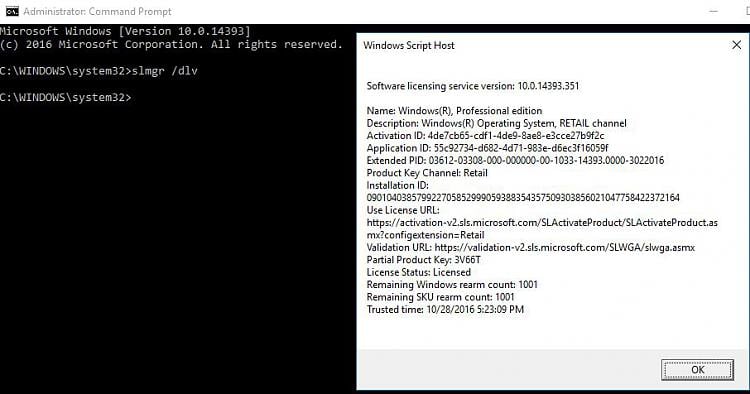If you are having problems activating Windows 10, Server 2016, Windows 8, or Server 2012 one of these three solutions below should get you through:
Activate your Windows 10 Pro with command prompt only. No need for any software and any product key. Your Windows activation is three steps far. Because most organizations will not immediately switch all computers to Windows 10, practical volume activation strategies must also take in to account how to work with the Windows 8.1, Windows 7, Windows Server 2012, and Windows Server 2008 R2 operating systems. This guide discusses how the new volume activation tools can support earlier. Thank you for posting your query in Microsoft Community. There are different methods of enabling Bluetooth in Windows 10. Type Settings in the search box. Click on Network and Internet. In the left pane, click on Flight Mode. Under “Wireless Device” and then “Bluetooth” change the switch from off to on to enable Bluetooth and switch it from on to off to disable Bluetooth.
Command Line to Launch Activation GUI:
This is handy if the GUI won’t start and you want to skip some steps to get it to work.
- click START (gets you to the tiles)
- type RUN
- type slui 3 and press ENTER
- yes, SLUI: which stands for SOFTWARE LICENSING USER INTERFACE
- SLUI 1 brings up the activation status window
- SLUI 2 brings up the activation window
- SLUI 3 brings up the CHANGE PRODUCT KEY window
- SLUI 4 brings up the CALL MICROSOFT & MANUALLY ACTIVATE window
- yes, SLUI: which stands for SOFTWARE LICENSING USER INTERFACE
- Type in your product key
- Have a nice day.
Step by step process on how to activate Windows 10 for free by using your command prompt. In Command Prompt: Use the command slmgr/ipk Your License Key Pr.
Command Line to Activate Windows Through Command Line:


- Launch a CMD as an Administrator
- Type: slmgr.vbs /ipk xxxxx-xxxxx-xxxxx-xxxxx-xxxxx
- Press Enter
If your key is valid and you are connected to the internet, it should activate within a second or two.
Call Microsoft Activation Center:
In Canada and the US, call the support line directly at 1 800-936-4900, otherwise, use this table of Microsoft Activation Phone Numbers to do the deed.

You also might find some of our previous posts on activation problems to be helpful: urtech.ca/?s=activation
-->Applies to
- Windows 10
- Windows Server 2012 R2
- Windows Server 2012
- Windows Server 2016
- Windows Server 2019
Looking for volume licensing information?
Looking for retail activation?
This guide is designed to help organizations that are planning to use volume activation to deploy and activate Windows 10, including organizations that have used volume activation for earlier versions of Windows.
Volume activation is the process that Microsoft volume licensing customers use to automate and manage the activation of Windows operating systems, Microsoft Office, and other Microsoft products across large organizations. Volume licensing is available to customers who purchase software under various volume programs (such as Open and Select) and to participants in programs such as the Microsoft Partner Program and MSDN Subscriptions.
Volume activation is a configurable solution that helps automate and manage the product activation process on computers running Windows operating systems that have been licensed under a volume licensing program. Volume activation is also used with other software from Microsoft (most notably the Office suites) that are sold under volume licensing agreements and that support volume activation.
Windows 10 Pro Activate Command Prompt
This guide provides information and step-by-step guidance to help you choose a volume activation method that suits your environment, and then to configure that solution successfully. This guide describes the volume activation features and the tools to manage volume activation.
Because most organizations will not immediately switch all computers to Windows 10, practical volume activation strategies must also take in to account how to work with the Windows 8.1, Windows 7, Windows Server 2012, and Windows Server 2008 R2 operating systems. This guide discusses how the new volume activation tools can support earlier operating systems, but it does not discuss the tools that are provided with earlier operating system versions.
Volume activation -and the need for activation itself- is not new, and this guide does not review all of its concepts and history. You can find additional background in the appendices of this guide. For more information, see Volume Activation Overview.
If you would like additional information about planning a volume activation deployment specifically for Windows 7 and Windows Server 2008 R2, please see the Volume Activation Planning Guide for Windows 7.
To successfully plan and implement a volume activation strategy, you must:
- Learn about and understand product activation.
- Review and evaluate the available activation types or models.
- Consider the connectivity of the clients to be activated.
- Choose the method or methods to be used with each type of client.
- Determine the types and number of product keys you will need.
- Determine the monitoring and reporting needs in your organization.
- Install and configure the tools required to support the methods selected.
Keep in mind that the method of activation does not change an organization’s responsibility to the licensing requirements. You must ensure that all software used in your organization is properly licensed and activated in accordance with the terms of the licensing agreements in place.
Activate Windows From Command
Additional information
